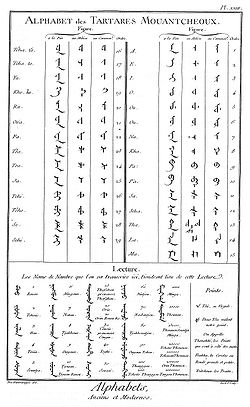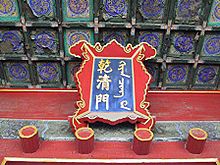Manchu alphabet
| Manchu script | |
|---|---|
 | |
| Script type | |
| Languages | Manchu language Xibe language |
| Related scripts | |
Parent systems | |


The Manchu alphabet was used for recording the now near-extinct Manchu language; a similar script is used today by the Xibe people, who speak a language descended from Manchu. It is written vertically from top to bottom, with columns proceeding from left to right.
History
According to the Veritable Records (Manchu: [[[Image:manju-1.png|55px]] manju-i yargiyan kooli] Error: {{Lang}}: text has italic markup (help); Chinese: 滿洲實錄; pinyin: Mǎnzhōu Shílù), in 1599 the Manchu leader Nurhaci decided to convert the Mongolian alphabet to make it suitable for the Manchu people. He decried the fact that while illiterate Han Chinese and Mongolians could understand their respective languages when read aloud, that was not the case for the Manchus, whose documents were recorded by Mongolian scribes. Overriding the objections of two advisors named Erdeni and G'ag'ai, he is credited with adapting the Mongolian script to Manchu. The resulting script was known as [tongki fuka akū hergen] Error: {{Lang}}: text has italic markup (help) ("script without dots and circles").
In 1632, Dahai added diacritical marks to clear up a lot of the ambiguity present in the original Mongolian script; for instance, a leading k, g, and h are distinguished by the placement of no diacritical mark, a dot, and a circle respectively. This revision created the Standard script, known as [tongki fuka sindaha hergen] Error: {{Lang}}: text has italic markup (help) ("script with dots and circles"). As a result, the Manchu alphabet contains little ambiguity. Recently discovered manuscripts from the 1620s make clear, however, that the addition of dots and circles to Manchu script began before their supposed introduction by Dahai.
Dahai also added ten graphemes (tulergi hergen: "foreign (outer) letters"), to allow Manchu to be used to write Chinese and Sanskrit loanwords. Previously, these words contained sounds that did not have corresponding letters in Manchu. [1] Sounds that were transliterated included the aspirated sounds kh, gh, hh; ts' (Chinese pinyin: c); ts (Chinese pinyin: ci); sy (Chinese pinyin: si); dz (Chinese pinyin: z); c'y (Chinese pinyin: chi); jy (Chinese pinyin: zhi); and ž (Chinese pinyin: r). [2]
By the middle of the nineteenth century, there were three styles of writing Manchu in use: standard script (ginggulere hergen), semicursive script (gidara hergen), and cursive script (lasihire hergen). Semicursive script had less spacing between the letters, and cursive script had rounded tails. [3]
Nature of script
Whether the Manchu script is alphabetic or a syllabary is disputed. Today, the opinion on whether it is alphabet or syllabic in nature is split between different experts. In China, it is considered syllabic and Manchu is still taught in this manner. The alphabetic approach is used mainly by foreigners who want to learn the language. Studying Manchu script as a syllabary takes a longer time.[4][5]
Chinese
The Manchu alphabet was also used to write Chinese, "Manchu: a textbook for reading documents " by Gertraude Roth Li contains a list comparing a romanization of Chinese syllables written in Manchu compared to pinyin and Wade Giles.[6] Using the Manchu script to transliterate Chinese words is a source of loanwords for the Xibe language.[7]
Alphabet
| Characters | Transliteration | Unicode | Notes | ||||
|---|---|---|---|---|---|---|---|
| isolated | initial | medial | final | ||||
| Vowels [8] | |||||||
| ᠠ | ᠠ᠊ | ᠊ᠠ᠊ | ᠊ᠠ | a | 1820 | ||
| ᠊ᠠ᠋ | |||||||
| ᡝ | ᡝ᠊ | ᠊ᡝ᠊ | ᠊ᡝ | e | 185D | Second final form is used after [k] [g] [x] kh gh hh [9] | |
| ( | |||||||
| ᡳ | ᡳ᠊ | ᠊ᡳ᠊ | ᠊ᡳ | i | 1873 | ||
| ᠊ᡳ᠌᠊ | |||||||
| ᠊ᡳ᠍᠊ | ᠊ᡳ᠋ | ||||||
| ᠊ᡳ᠌ | |||||||
| ᠣ | ᠣ᠊ | ᠊ᠣ᠊ | ᠊ᠣ | o | 1823 | ||
| ᠊ᠣ᠋ | |||||||
| ᡠ | ᡠ᠊ | ᠊ᡠ᠊ | ᠊ᡠ | u | 1860 | ||
| ?? | |||||||
| ᡡ | ᡡ᠊ | ᠊ᡡ᠊ | ᠊ᡡ | ū/uu/v | |||
| ᡟ | ( |
᠊ᡟ᠊ | ᠊ᡟ | y/y/i' | 185F | ||
| Consonants [10] | |||||||
| |
|
|
n | 1828 | First medial form is used before vowels; second is used before consonants | ||
| | |||||||
| |
ng | 1829 | First medial form is used before i o u ū; second is used before e i | ||||
| |
|
|
k [q] | 1874 | First medial form is used before a o ū; second is used before consonants | ||
| | |||||||
| |
|
|
k [k] | 1874 | |||
| |
g [ɢ] | 1864 | |||||
| g [g] | 1864 | ||||||
| h [χ] | 1865 | ||||||
| h [x] | 1865 | ||||||
| |
|
|
b | 182A | |||
| p | 1866 | ||||||
| |
|
|
s | 1867 | |||
| š | 1867 | ||||||
| |
|
|
t | 1868 | First initial and medial forms are used before a o i; second initial and medial forms are used before e u ū; | ||
| d | 1869 | First initial and medial forms are used before a o i; second initial and medial forms are used before e u ū | |||||
| |
|
|
l | 182F | |||
| |
|
|
m | 182E | |||
| |
|
c/ch/c | 1834 | ||||
| |
|
j/zh/j | 1835 | ||||
| |
|
r | 1875 | ||||
| f | 1875 | First initial and medial forms are used before a e; second initial and medial forms are used before i o u ū | |||||
| |
| ||||||
| |
|
— | v (w) | 1838 | |||
Punctuation
The Manchu alphabet has two kinds of punctuation: two dots (᠉), analogous to a period; and one dot (᠈), analogous to a comma. However, with the exception of lists of nouns being reliably punctuated by single dots, punctuation in Manchu is inconsistent, and therefore not of much use as an aid to readability. [11]
The equivalent of the question mark in Manchu script consists of some special particles, written at the end of the question. [12]
Jurchen script
The Jurchens were the ancestors of the Manchus, and their language, the Jurchen language is ancestral to the Manchu language, and their script was derived from the Khitan script, which was in turn derived from Chinese, but the Jurchen script has no relation to the Manchu alphabet.
See also
References
- ^ Gorelova, L: "Manchu Grammar", page 50. Brill, 2002.
- ^ Gorelova, L: "Manchu Grammar", pages 71-72. Brill, 2002.
- ^ Gorelova, L: "Manchu Grammar", page 72. Brill, 2002.
- ^ Gertraude Roth Li (2000). Manchu: a textbook for reading documents. University of Hawaii Press. p. 16. ISBN 0824822064. Retrieved 25th of March, 2012.
Alphabet: Some scholars consider the Manchu script to be a syllabic one.
{{cite book}}: Check date values in:|accessdate=(help) - ^ Gertraude Roth Li (2010). Manchu: A Textbook for Reading Documents (Second Edition) (2 ed.). Natl Foreign Lg Resource Ctr. p. 16. ISBN 0980045959. Retrieved 1st of March, 2012.
Alphabet: Some scholars consider the Manchu script to be a syllabic one. Others see it as having an alphabet with individual letters, some of which differ according to their position within a word. Thus, whereas Denis Sinor aruged in favor of a syllabic theory,30 Louis Ligeti preferred to consider the Manchu script and alphabetical one.31
{{cite book}}: Check date values in:|accessdate=(help)() - ^ Gertraude Roth Li (2000). Manchu: a textbook for reading documents. University of Hawaii Press. p. 370. ISBN 0824822064. Retrieved 25th of March, 2012.
Manchu transliteration of Chinese syllables Some Chinese syllables are transliterated in different ways. There may be additional versions to those listed below. *W-G stands for Wade-Giles
{{cite book}}: Check date values in:|accessdate=(help) - ^ Gertraude Roth Li (2000). Manchu: a textbook for reading documents. University of Hawaii Press. p. 294. ISBN 0824822064. Retrieved 25th of March, 2012.
f) Transliteration of Chinese words and compounds. Though most Chinese words in Manchu are easily recognizable to students familiar with Chinese, it is helpful to remember the most important rules that govern the transliteration of Chinese words into Manchu.
{{cite book}}: Check date values in:|accessdate=(help); line feed character in|quote=at position 51 (help) - ^ Gorelova, L: "Manchu Grammar", page 59. Brill, 2002.
- ^ Gorelova, L: "Manchu Grammar", page 53. Brill, 2002.
- ^ Gorelova, L: "Manchu Grammar", page 70. Brill, 2002.
- ^ Li, G: "Manchu: A Textbook for Reading Documents", page 21. University of Hawai'i Press, 2000.
- ^ Gorelova, L: "Manchu Grammar", page 74. Brill, 2002.
